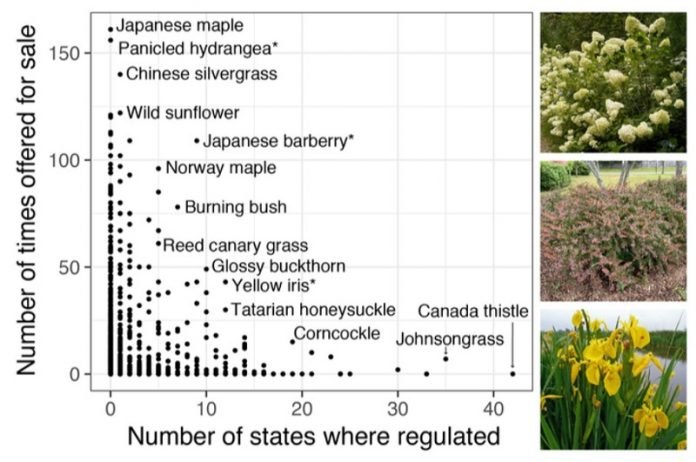
A new study shows that 1,330 nurseries, garden centers and online retailers are still offering hundreds of invasive plant species as ornamental garden plants.
This includes 20 species that are illegal to grow or sell nationwide.
The study shows that existing regulatory and ethical guidelines do not serve to limit the widespread introduction of invasive plants and that more than 60% of the 1,285 plants identified as invasive remain for sale.
“Once we’ve recognized that an ornamental plant can be invasive, we would hope that commercial sales of that species would stop,” says lead author Evelyn M. Beaury, a graduate student in organismic and evolutionary biology at UMass.
“But our findings show that our current framework for removing invasive plants from plant trade isn’t working.
States are generally doing a good job limiting sales of their own regulated plants, but we found major inconsistencies in what’s being regulated across state borders.
Nearly all states had at least one of their regulated plants sold in a neighboring state.”
“We’ve known for decades that many gardening and landscaping plants are invasive,” adds Bethany Bradley, senior author and professor of environmental conservation at UMass, “but we’ve done little to stop propagating them. We can do better.”
Beaury and her co-authors suggest that regional regulation, plus outreach to growers and consumers, is needed to reduce the ongoing propagation of plants known to be invasive in the United States.
Some remedies include increasing consistency in regulations, more coordination among states at regional and national levels and providing growers with transparent information to support efforts that reduce the spread of invasive plants.
In addition to the Federal Noxious Weed Act, which identifies 105 plants considered the greatest threats to U.S. natural resources, most states have regulatory lists intended to reduce the spread of high-impact invasive plants.
Other non-native plants are managed by state and federal agencies or conservation organizations.
“The most concerning case of federally designated noxious weed sales,” Beaury and colleagues say, is the availability of cogongrass (Imperata cylindrica), offered by 33 vendors in 17 states. It is labeled as one of “the world’s most invasive plants.”
“This is a tricky case,” says Beaury, “because plant breeders are marketing a sterile cultivar. But research shows these plants are not completely sterile and can still become invasive.”
For this study, the researchers used standardized searches in Google and a database of nursery catalogs to identify invasive plants in the U.S. that continue to be sold.
They also recorded the location and distribution of vendors and sales across the lower 48 states, and which sales took place even when federal and/or state regulations prohibit them.
The authors report that they found that 61% of 1,285 plant species identified as invasive in the U.S. remain available through the plant trade, including 50% of state-regulated species and 20% of federal noxious weeds, with vendors in all the lower 48 states.
These vendors included large online marketplaces like eBay and Amazon where users can easily ship invasive plants across state borders, likely without consequence.
“While patchy state regulations definitely contribute to the widespread availability of invasive plants in the U.S., it’s clear we as a public also lack awareness about which plants are invasive and how they spread to new areas.”
Although there are barriers to enforcement, Beaury says that “we’ve already heard from state regulators that have used our results to follow up with growers selling invasive species.
This is great news, and if we want to continue to protect native ecosystems, regulators and managers need more resources to do so.”



